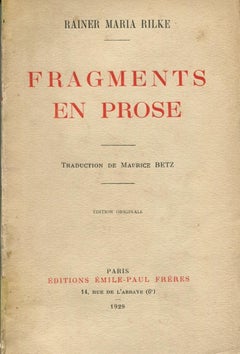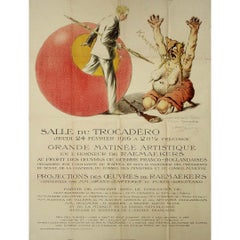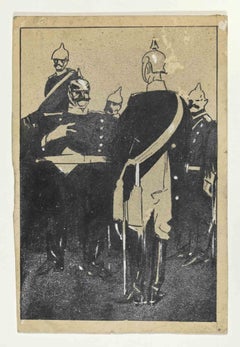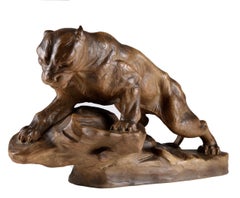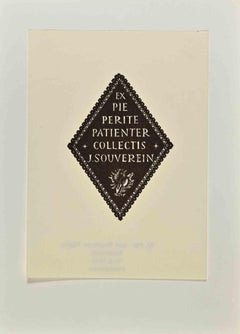1910s Art
to
270
1,085
356
394
190
170
Overall Width
to
Overall Height
to
7,548
21,290
159,149
232,532
1,970
2,247
4,944
6,414
5,819
13,319
19,792
25,696
18,300
13,586
5,389
411
314
138
138
47
20
19
12
6
1
1,228
884
32
1,427
690
593
409
386
351
216
151
144
137
132
122
115
100
97
92
77
76
59
57
866
629
486
396
385
95
52
34
23
22
852
363
1,171
951
Period: 1910s
Fragment en Prose - Rare Book - 1920s
Located in Roma, IT
Translated in french by Maurice Betz, from the original "Prosafragmente" by Rainer Maria Rilke. Edition of 675 copies. Copy on Outhenin-Chalandre paper. Spine lightly worn, perfect c...
Category
Surrealist 1910s Art
Materials
Paper
1916 poster for the Grande Matinée Artistique en l'Honneur de Raemaekers
Located in PARIS, FR
During World War I, artistic and cultural events played a crucial role in supporting humanitarian efforts and boosting morale. Among the notable artifacts from this period is the 191...
Category
1910s Art
Materials
Paper, Lithograph
Austrian Soldiers - Drawing by Gabriele Galantara - 1916
Located in Roma, IT
Austrian Soldiers is a modern artwork by Gabriele Galantara (1865-1937) in 1916.
The artwork was realized in China ink and watercolor on cardboard.
...
Category
Modern 1910s Art
Materials
Ink, Pen, Watercolor
Early 1900 Art Deco Terracotta Sculpture " a panther on a rock " 19Th
Located in Gavere, BE
Outstanding sculpture depicting a panther in an attacking position, standing on a rock.
The sculpture has a beautiful patina. It displays excellent muscular proportions.
Made from ...
Category
Art Deco 1910s Art
Materials
Terracotta, Clay
Who Made it an Issue of Six Shooters, (California Mine; Copper Sky)
Located in Fort Washington, PA
Medium: Oil on Canvas (on Board)
Signature: Signed Lower Left
Literature:
Reese, Lowell Otus, The Little Injun, Collier's Weekly, November 4, 1916, p. 13, illustrated. Schoonover,...
Category
1910s Art
Materials
Canvas, Oil
Ex Libris - Woodcut by M. Pot Van Regteren Altena - 1914
Located in Roma, IT
Ex Libris - Pie Perite Patienter Collectis J. Souverein is a Modern Artwork realized in 1914, by M. Pot Van Regteren Altena, from Nederland.
B/W Woodcut on ivory paper. Signed on p...
Category
Modern 1910s Art
Materials
Paper, Woodcut
ROBERT PEARY, THE LORD MAYOR OF MANCHESTER, ENGLAND AND OTHERS.
Located in Portland, ME
Unknown Photographer. ROBERT PEARY, THE LORD MAYOR OF MANCHESTER, ENGLAND AND OTHERS. Gelatin silver print, 1910. The image shows Commander Peary with Cha...
Category
1910s Art
Materials
Silver Gelatin
Dawn (or, Kneeling Figure)
Located in New York, NY
Arthur B. Davies (1862-1928), Dawn (or, Kneeling Figure), 1918, soft ground etching and aquatint, signed in pencil lower right. Reference: Czestochowski 59, second state (of 3). In v...
Category
1910s Art
Materials
Etching, Aquatint
Ex Libris - J. Sigale's - Woodcut by José (Josepe) Viola - 1911
Located in Roma, IT
Ex Libris - J. Sigale's is a Modern Artwork realized in 1911 s. by José (Josepe) Viola.
Ex Libris. B/W woodcut on paper.
The work is glued on ivory cardboard. Signed on plate an...
Category
Modern 1910s Art
Materials
Woodcut
“Late in the Day”
Located in Southampton, NY
Oil on wooden panel by the Spanish artist, Thomas Campuzano y Aguirre. Seated man on a large rock with a hat with a woman with basket standing close by. Circa 1910. In very good o...
Category
Post-Impressionist 1910s Art
Materials
Oil, Board
$1,280 Sale Price
20% Off
Anshutz on Anatomy
By John Sloan
Located in New York, NY
John Sloan (1871-1951), Anshutz on Anatomy, etching, 1912, signed titled and inscribed “100 proofs” by the artist, and also signed “Ernest Roth imp” by the printer. Reference: Morse 155, eighth state (of 8), from the edition of 80. In very good condition, the full sheet, printed in dark brown ink on a brown/tan wove paper, 7 1/2 x 9, the sheet 11 1/8 x 12 3/4 inches.
A fine impression.
Sloan wrote of this print: “Tom Anshutz, our old teacher at the Pennsylvania Academy, gave anatomical demonstrations of great value to art students. Modelling the muscles in clay, he would then fix them in place on the skeleton. Those present in this etched record of a talk in Henri’s New York class include: Robert and Linda Henri, George Bellows, Walter Pach...
Category
American Realist 1910s Art
Materials
Etching
Le Rêve - Etching and Drypoint by Anselmo Bucci - 1917
Located in Roma, IT
Le Rêve-from "Le Croquis du Front Italien" is an Artwork, Drypoint, realized by the Italian Artist Anselmo Bucci, in 1917.
Hand signed on the right margin . Edition n. 18/100 specimens on Hollande paper. From the collection: “Croquis du Front Italien” , published in Paris by D'Alignan editions.
Good conditions, except for a light yellowing of the paper and some foxing.
Anselmo Bucci (1887-1955) was an Italian painter and printmaker.
He took part in the Salon des Indépendants from 1910 on. He enlisted in the Volunteer Cyclist Battalion in 1915 and he became one of the most famous Italian war...
Category
Modern 1910s Art
Materials
Etching, Drypoint
Drinkers - Etching By Pierre Georges Jeanniot - 1914
Located in Roma, IT
Drinkers is an Etching realized by Georges Jeanniot in 1914.
Signed on the lower, titled.
Good condition.
Category
Modern 1910s Art
Materials
Etching
Fruit Sellers - Lithograph by Georges Gobo - 1910s
By Georges Gobo
Located in Roma, IT
Fruit Sellers is a lithograph on ivory-colored paper realized by Georges Gobo.
Signed on the plate.
Good Conditions with slight foxing.
The artwork is created through deft rapid str...
Category
Modern 1910s Art
Materials
Lithograph
Les Vins de Bourgogne.
By Guy Arnoux
Located in New York, NY
Les Vins de Bourgogne. printed by Devambez, Paris, signed in the
plate. 1916. Color lithograph. On Linen
Guy Arnoux is an artist , illustrator and graphic designer French.
He ...
Category
Art Deco 1910s Art
Materials
Lithograph
Impressionist Interior Still Life, German, 1920s, Munich Artist Group Scholle
Located in Eltville am Rhein, DE
Reinhold Max Eichler
Mutzschen 1872 - 1947 Munich
At the Blue Curtain
Oil on wood
Signed lower left
Size: 110 x 81 cm
Frame: 127 x 99 cm
Good condition (see photos)
Provenance: Kunsthaus Brakls Munich 1925, Galerie Commeter Hamburg
Rare large-format, museum-quality painting by the Munich artists' group "Scholle"
Viewing and collection by appointment are welcome.
Authenticity will be confirmed in writing.
Reinhold Max Eichler was born in 1872 in Hubertusburg, Mutzschen, Saxony, the son of a farmer. He initially studied at the Dresden Academy of Fine Arts from 1889 to 1893. He then transferred to the Academy of Fine Arts in Munich to study under Paul Hoecker. In 1896, he became a contributor to the magazines Jugend and Simplicissimus, for which he produced illustrations, and in 1899, he joined the artists' association Die Scholle. From 1903 onward, he worked exclusively for Jugend. Members of Die Scholle included, besides Eichler, Gustav Bechler, Hansl Bock, Ludwig Bock, Edward Cucuel, Erich Erler (Samaden), Fritz Erler, Max Feldbauer, Walter Georgi, Adolf Höfer, Adolf Münzer...
Category
1910s Art
Materials
Oil
"Ponctua (Clock), " Advertisement Vintage Poster signed by Rene Prejelan
By Rene Prejelan
Located in Milwaukee, WI
Original color lithograph poster by Rene Prejelan.
Ponctua (The best and least expensive precision watch), 1910.
A fine watch at a fine price- and the...
Category
1910s Art
Materials
Lithograph
BOSBOOM. 1917.
Located in New York, NY
ROLAND HOLST, R.N. (Richard) (1868-1938). “Eere Tentoonstelling Bosboom/ 1817 1917/ Pulchri-Studio ‘s Gravenhage/ 21 Apr[il] 31 Mei”. Color lithograph (pa...
Category
Symbolist 1910s Art
Materials
Lithograph
Sketch - Drawing by Henry Gabriel Ibels - 1915
Located in Roma, IT
Sketch is an Original China Ink Drawing realized by Henry Gabriel Ibels in 1915.
Good condition on a yellowed paper.
Hand-signed, dated on the lower right corner.
Henri-Gabriel Ib...
Category
Modern 1910s Art
Materials
Ink
$621 Sale Price
20% Off
L'Argent qu'on Prete - Lithograph by Victor Prouvé - 1917
Located in Roma, IT
L'Argent qu'on Prete is a Lithograph realized by Victor Prouvé in 1917.
Good condition on a brown paper.
Signed and dated under the drawing, stamped by Berger-Levrault (Paris-Nancy).
Victor Prouvé, born 13 August 1858 in Nancy, dead 15 February 1943 at Sétif (Algeria), was a French painter, sculptor and engraver of the Art Nouveau École de Nancy. He designed decors of glass works and furniture for Émile Gallé. He worked for Eugène Vallin...
Category
Modern 1910s Art
Materials
Lithograph
Reims The Cathedral in Flames - Original Lithographby Charles Jouas - 1914
Located in Roma, IT
Reims The Cathedral in Flames is a Lithograph realized by Charles jouas in 1914.
Good condition on a yellowed paper.
Titled and dated on the upper margin, Editor and gallery on the...
Category
Modern 1910s Art
Materials
Paper, Lithograph
Antwerp
By Erich Heckel
Located in New York, NY
Erich Heckel (1883-1970), Antwerp, drypoint, 1914, signed and dated in pencil lower right margin. Reference: Dube 123. In excellent condition, the full sheet on a cream/ivory wove pa...
Category
Expressionist 1910s Art
Materials
Drypoint
Greco ou le secret de Tolede -Original Woodcut print by Henri Louis Bracons-1918
Located in Roma, IT
Greco ou le secret de Tolede is a woodcut print realized by Henri Louis Bracons
Hand-signed on the lower right in pencil. Numbered on the lower left, the edition of 27/50 prints. Pa...
Category
Modern 1910s Art
Materials
Woodcut
Country House - Drawing by Jean Chapin - 1950s
By Jean Chapin
Located in Roma, IT
Country House is an ink and watercolor drawing realized by Jean Chapin in the mid-20th century.
Signature stamp on the lower left margin.
Good conditions.
Jean Chapin is a Fren...
Category
Modern 1910s Art
Materials
Watercolor
The Old Man - Original Pencil Drawing by Bernard Bécan - 1913
Located in Roma, IT
The Old Man is an original drawing in pencil realized in 1913 by Bernard Bécan (1890-1943), applied on a White Passepartout.
Hand-Signed and dated on th...
Category
Modern 1910s Art
Materials
Pencil
Round of Summer (aka Four Figures), First State Proof
Located in New York, NY
Arthur B. Davies (1862-1928), Round of Summer (aka Four Figures), soft ground etching, 1919, signed in pencil lower right. Reference: Czestochowski 91, first state (of 3), trial proo...
Category
American Impressionist 1910s Art
Materials
Etching
The Joys of the Hairy - Woodcut Print by Pierre Abadie-Landel - 1917
Located in Roma, IT
The Joys of the Hairy is a woodcut print realized by Pierre Abadie-Landel (1896-1972) in 1917.
This woodcut print is contained in a white passepartout (40x32.5 cm).
Good condition....
Category
Modern 1910s Art
Materials
Woodcut
Frauenprofil (Profile of a Woman)
By Emil Nolde
Located in New York, NY
Emil Nolde (1867-1956), Frauenprofil (Profile of a Woman), woodcut, 1917, signed in pencil lower right (also titled, numbered 8, and annotated III.10 lower left). Reference: Schiefle...
Category
Expressionist 1910s Art
Materials
Woodcut
Original 1915 poster featuring Lord Kitchener's iconic proclamation WWI
Located in PARIS, FR
The original 1915 poster featuring Lord Kitchener's iconic proclamation serves as a powerful artifact of World War I propaganda, encapsulating the urgency and fervor of the times. With the backdrop of the Great War raging across Europe, governments on both sides sought to rally their citizens to support the war effort in various ways, including recruitment, fundraising, and industrial production.
The poster's message is clear and direct, conveying the urgency of the situation and the need for immediate action. The central quote from Lord Kitchener emphasizes the critical importance of three key resources: men, materials, and money. These were seen as the essential elements necessary to sustain the war effort and ensure victory on the battlefield.
Lord Kitchener, as the British Secretary...
Category
1910s Art
Materials
Paper, Lithograph
Drawing on Paper Titled "The Card Game" by Marguerite Zorach, 1912
Located in New York, NY
Marguerite Zorach, 1887-1968
The Card Game, 1912
Ink on paper
9 ¼ x 12 inches
Signed and inscribed (on verso): Marguerite Zorach Playing Cards/Calif./1912.”
ZoraM-02
Category
1910s Art
Materials
Paper, Ink
L'Oeuf est Cuit - Original Drawing by Leka - 1910s
Located in Roma, IT
L'oeuf est cuit is an original satiric artwork realized by the illustrator Leka.
Ink and watercolor.
Hand-signed on the lower left by Leka. Titled on the lower right. Dated 1914-19...
Category
Modern 1910s Art
Materials
Watercolor, Ink
Le Plus bel Oeuf de Pâques - Original Drawing by Leka - 1910s
Located in Roma, IT
Le plus bel oeuf de Pâques is an original satiric artwork realized by the illustrator Leka .
Ink and watercolor.
Hand-signed on the lower right by Leka.Titled on the lower center. ...
Category
Modern 1910s Art
Materials
Watercolor, Ink
Alea Iacta Est - Etching by Benito (Edmond Garcia) - 1914
Located in Roma, IT
Alea Iacta Est is an original etching realized in1914 by Benito (Edmond Garcia, 1891-1961).
Good condition. Edition 29/50
The artwork is depicted through strong strokes in a well-b...
Category
Modern 1910s Art
Materials
Etching
Magazine "Numero" number 76 - Original Lithograph - 1910s
Located in Roma, IT
Magazine "Numero" number 76, Original Lithograph realized in the 1910s.
Good conditions but aged.
Humorous illustrated weekly, released in Turin on a monthly basis from 1914 to 191...
Category
Modern 1910s Art
Materials
Magazine Paper
Soldiers at the Front - Original Etching by Anselmo Bucci - 1917
Located in Roma, IT
Soldier at the Front is an original etching realized by Anselmo Bucci in 1917.
Limited edition of 200 copies.
The artwork represent a soldier at the front during War World 1st, 19...
Category
Modern 1910s Art
Materials
Etching
Children in Mulberry Street
By Jerome Myers
Located in New York, NY
Jerome Myers (1867-1940), Children in Mulberry Street, c. 1910, soft ground etching and plate tone, signed in pencil lower right. In good condition (apart from weakening at platemark...
Category
American Realist 1910s Art
Materials
Etching
Soldiers at the Front - Original Etching by Anselmo Bucci - 1917
Located in Roma, IT
Soldiers at the Front is an original etching realized by Anselmo Bucci in 1917.
Limited edition of 200 copies.
The artwork represent a soldier at the front during the War World 1st...
Category
Modern 1910s Art
Materials
Etching
The Priest -l Drawing by Gabriele Galantara - 1910s
Located in Roma, IT
The priest is an original drawing in China ink realized by Gabriele Galantara in the 1910s.
The status of preservation Good.
The artwork is depicted skill...
Category
Modern 1910s Art
Materials
Ink
Torment
Located in New York, NY
Arthur B. Davies (1862-1928), Torment, soft ground etching with aquatint and roulette, 1919-20, signed with the estate stamp lower right, and signed by the printer Frank A. Nankivell...
Category
American Impressionist 1910s Art
Materials
Etching, Aquatint
Kaller's [Top Hat and Gloves on Chair].
By Jules de Praetere
Located in New York, NY
1918. Color lithograph. On Linen.
Julius de Praetere (Jules de Prater) was a Belgian painter, graphic designer, university lecturer and publisher in the field arts and textile de...
Category
Art Deco 1910s Art
Materials
Lithograph
The Study of Sportive Figures - Drawing - 1910s
Located in Roma, IT
The study of sportive figures is an original drawing in pencil on creamy paper realized by an anonymous artist in the 1910s
Good condition.
The artwork rep...
Category
Modern 1910s Art
Materials
Pencil
"Nail Fetish Bacongo-Zaire, " Glass, Wood, & Metal created circa 1910
Located in Milwaukee, WI
"Nail Fetish Bacongo-Zaire" is a sculpture made of glass, wood, and metal created circa 1910. He has a top hat upon his head and face paint. Their right ha...
Category
Tribal 1910s Art
Materials
Metal
Resurrection (aka Flying Figures; Border of the Lake)
Located in New York, NY
Arthur B. Davies (1862-1928), Resurrection (aka Flying Figures; Border of the Lake), drypoint and aquatint on zinc, 1916, signed with the estate stamp lower right. Reference: Price 2...
Category
American Impressionist 1910s Art
Materials
Drypoint, Aquatint
"Yesterday afternoon he was decorated with the Croix de Guerre" World War I
Located in Fort Washington, PA
World War I scene
Story illustration for “Will You Tell Her I’m All Right?” by Catherine Van Dyke for The Ladies Home Journal, published March 1918, illustrated page 11.
The full c...
Category
1910s Art
Materials
Canvas, Oil
Armistice Day, 1918
Located in New York, NY
William Meyerowitz (1898-1981), Armistice Day, 1918, etching with watercolor.
Edition not stated. Signed in pencil. Signed and dated in the plate, lower left.
Image size 9 3/4 ...
Category
American Impressionist 1910s Art
Materials
Watercolor, Etching
Military - Original Etching by Anselmo Bucci - 1910s
Located in Roma, IT
"Military" is a beautiful print in the etching technique, realized by Anselmo Bucci (1887-1955) in 1910s.
In good conditions.
The artwork represents the war scenery and an only pe...
Category
Modern 1910s Art
Materials
Etching
Girl Running (or Woman Running)
Located in New York, NY
Arthur B. Davies (1862-1928), Girl Running (or Woman Running), drypoint, 1917, signed in pencil (twice) lower left and dated lower right. Reference: Czes...
Category
American Impressionist 1910s Art
Materials
Drypoint
La Receveuse
Located in New York, NY
Jean-Emile Laboureur (1877-1943), La Receveuse, engraving, 1919-1920, signed in pencil lower left, numbered (2/38) lower right and annotated ”imp” [also with initials and the date 19...
Category
Cubist 1910s Art
Materials
Engraving
Soldier at the Front - Original Etching by Anselmo Bucci - 1917
Located in Roma, IT
Soldier at the Front is an original etching realized by Anselmo Bucci in 1917.
Limited edition of 200 copies.
The artwork represent a soldier at the front during the 1 war 1915/191...
Category
Modern 1910s Art
Materials
Etching
La Fumee du Bateau
Located in New York, NY
Jean-François Raffaëlli (1850-1924), La Fumee du Bateau, color etching and drypoint, 1911, signed and numbered in pencil lower right. Reference: Delteil 98. In very good condition, ...
Category
Realist 1910s Art
Materials
Drypoint, Etching
Tightrope Dancer
Located in New York, NY
ROYDS, Mabel Allington. Tightrope Dancer, ca 1911. Color woodcut. MB 1. From a small edition. Signed and titled in pencil.
After working with Walter Sickert in Paris at the turn ...
Category
Realist 1910s Art
Materials
Woodcut
A Street in Ventnor, Isle of Wight
Located in New York, NY
Theodore Roussel (1847-1926), A Street in Ventnor, Isle of Wight, etching, soft ground etching, drypoint, 1912, signed in pencil on the tab and inscribed...
Category
Impressionist 1910s Art
Materials
Drypoint, Etching
Sketch For L'Asino- China ink and Watercolor by Gabriele Galantara - 1910
Located in Roma, IT
Sketch for L’Asino is an original drawing in China ink, whit lead and watercolor realized by Gabriele Galantara in 06.02.1910
The state of preservation of the artwork is good on age...
Category
Modern 1910s Art
Materials
Ink, Watercolor
Der Todseher - Rare Book Illustrated by Alfred Kubin - 1910
Located in Roma, IT
Der Todseher is an original modern rare book written by Ernst Adolf Willkomm (Herwigsdorf, 1810 - Zittau, 1886) and illustrated by Alfred Leopold Isidor Kubin (Leitmeritz, 1877 – Zwickledt, 1959) in 1910.
Original Edition.
Published by Barsdorf, Berlin.
30 numbered copies of deluxe issue.
Format: in 8°.
The book includes 284 pages with six full page drawings.
Mint conditions.
Alfred Leopold Isidor Kubin (Leitmeritz, 1877 – Zwickledt, 1959) in 1910. He was an Austrian printmaker, illustrator, and occasional writer. Kubin is considered an important representative of Symbolism and Expressionism. Kubin is considered an important representative of Symbolism and Expressionism and is noted for dark, spectral, symbolic fantasies, often assembled into thematic series of drawings. Like Oskar Kokoschka and Albert Paris Gütersloh, Kubin had both artistic and literary talent. He illustrated the works of Edgar Allan Poe, E. T. A. Hoffmann, and Fyodor Dostoevsky, among others. Kubin also illustrated the German fantasy magazine Der Orchideengarten.
Ernst Adolf Willkomm (Herwigsdorf, 1810 - Zittau, 1886). Willkomm was a German writer. Willkomm has published time-critical novels, travel sketches and short stories. With the title of his novel Die Europamüden in 1838 he took up a key word that had been coined by Heine in 1828 and with which an important aspect of thinking in the Vormärz was recorded. In the years 1845/46 Willkomm undertook a trip to Italy, whose experiences he processed in 1847 in the travel sketches Italian...
Category
Symbolist 1910s Art
Materials
Paper, Photogravure
Czarisme - China Ink and Watercolor by Gabriele Galantara - 1910s
Located in Roma, IT
Czarisme is an original Drawing in pencil and pen realized by Gabriele Galantara.
Good conditions except for diffused foxings and two rippings at the bottom margin.
The artwork is ...
Category
Modern 1910s Art
Materials
Ink, Watercolor
La Fille aux Oies
Located in New York, NY
Jean-Emile Laboureur (1877-1943), La Fille aux Oies, engraving, 1916, signed in pencil lower left, numbered (4/40) lower right and inscribed “imp,” also titled lower left margin edge...
Category
Cubist 1910s Art
Materials
Engraving
Anzacs
Located in New York, NY
Jean-Emile Laboureur, Anzacs, woodcut, 1918-22, signed and numbered (7/45), the second state (of 2). Reference: Sylvain Laboureur 713. In good condition, with remains of old hinges ...
Category
Cubist 1910s Art
Materials
Woodcut
Il Pantegan - Rare Book Illustrated by Walter Gramatté - 1919
Located in Roma, IT
Il Pantegan is an original modern rare book written by Victor Hedwig and illustrated by Walter Gramatté (Berlin, 1897 – Hamburg, 1929) in 1919.
Origina Edition.
500 numbered and s...
Category
Modern 1910s Art
Materials
Paper, Etching
Posinsky - Rare Book by Rudolf Grossmann - 1917
Located in Roma, IT
Posinsky is an original modern rare book illustrated written by Carl Sternheim (Lipsia, 1878 – Ixelles, 1942) and illustrated by Rudolf Grossmann (Freiburg, 1882 - Freiburg, 1941) in 1917.
Original First Edition.
Published by Heinrich Hochstim, Berlin.
Format: small 8°.
The book includes 65 pages with Seven full page Lithographs, cover included.
Good conditions.
Rudolf Grossmann (Freiburg, 1882 - Freiburg, 1941) was a German painter and graphic artist. He is particularly well known for his portrait drawings of famous contemporary figures. With his friend, Jules Pascin, he travelled to Belgium and Holland. Later study trips took him to Northern and Southern France, then to Vienna, Budapest and Stockholm. In 1910, he stayed briefly in Berlin, then continued his travels; this time to Engadin (near Munich), the Tegernsee and Italy, where he lived with his friend, Hans Purrmann...
Category
Modern 1910s Art
Materials
Paper, Lithograph
Farmer - Original Drawing by G. Galantara - 1909
Located in Roma, IT
Farmer is an original China ink drawing by Gabriele Galantara (April 4, 1909).
The artwork is in good conditions mounted on a white cardboard passpartout (50x35).
Gabriele Galanta...
Category
1910s Art
Materials
Ink
